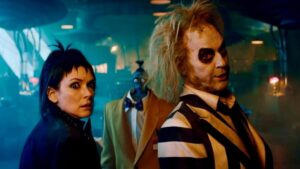
What a disappointment this sequel is. I didn’t have high expectations, but it still missed those by a mile.
When Tim Burton made “Beetlejuice” in 1988, it was surprisingly clever, original, and funny. None of those adjectives apply to “Beetlejuice Beetlejuice.” In fact, the only worthwhile part is seeing Michael Keaton’s return as the title character — but only in small chunks. He told GQ his one condition for doing this project was his character’s screen time be limited, as it was in the original:
The idea was, no, no, no, you can’t load it up with Beetlejuice, that’ll kill it. I think the Beetlejuice character doesn’t drive the story as much as he did in the first one. He’s more part of the storyline in this one as opposed to the first one, which is a case of, this thing comes in and drives the movie a little bit.
Burton got that right, but that’s not enough to make up for the rest of the movie, which is over-written and manically edited. It may spring from the same well, but the water’s gotten awfully murky in the intervening years.
As for the rest of the cast, Catherine O’Hara looks like she’s having a blast reprising her character (Delia), but the other returnee, Winona Ryder (Lydia), offers only two facial expressions: one with her eyebrows down to show intensity and the other with eyebrows up (and forehead furrowed) to show surprise and/or fear. She also looks like she’s wearing a wig thrown away by Elvira.
Jenna Ortega plays Lydia’s daughter, Astrid, which is not much of a stretch from her lead role in the TV series, “Wednesday.” Someone has to tell Ortega to take roles that don’t involve so much eyeliner. The supporting cast also includes Willem Dafoe, Monica Bellucci, and Justin Theroux, all of whom try too hard (a complaint you can usually blame on the director).
Unfortunately, the sequel suffers from the absence of two characters. In the original “Beetlejuice,” Geena Davis and Alec Baldwin offered us a likable duo to root for, a newly dead couple trying to haunt and scare the new residents of their house so they’ll get out. Without them, “Beetlejuice Beetlejuice” has no characters worth cheering on. It is, however, full of gory special effects — some of which really push the envelope of its PG-13 rating — and unnecessary callbacks to its predecessor (I’m talking about you, sand worms!).
“Beetlejuice” had a fun scene in which the living characters were possessed and made to dance around to Harry Belafonte’s “The Banana Boat Song (Day-O).” This time, Burton dug into the musical history bag and decided to do an extended number in which characters in a church are forced to sing along to “MacArthur Park.” That Jimmy Webb song was an unlikely hit in 1968 for Richard Harris and covered dozens of times since, most notably in a disco version by Donna Summer which was a big hit in 1978 and is heard behind the opening credits of “Beetlejuice Beetlejuice.” I doubt that anyone under 40 has ever heard either version, so why Burton chose it is a mystery.
The same applies to the sequence accompanied by the Bee Gees’ 1979 hit “Tragedy.” The appearance of both songs, which are even older than the original movie, is about as appetizing as a cake left out in the rain.
Similarly, there’s a scene in the afterlife where the souls of dead people have to board a train. Yep, The Soul Train, another reference from decades ago made worse by having everyone in the scene dancing in outfits from the TV show’s heyday in the 1970s. I wonder if Burton has to pay royalties to the estate of “Soul Train” creator and host Don Cornelius.
I recognize that I’m in the minority on this one, since “Beetlejuice Beetlejuice” has already racked up nearly $200 million at the box office. But it left me bored and wishing I hadn’t wasted my time, so I can only rate it a 2 out of 10.
If you want to see a very good recent Michael Keaton movie, I recommend the one he directed and starred in earlier this year, “Knox Goes Away.” It’s streaming now on Max (read my review here).
